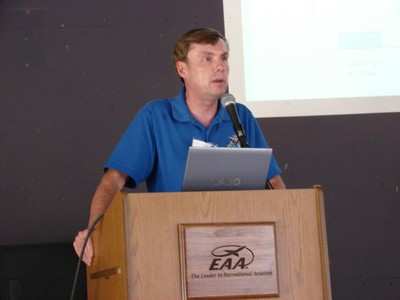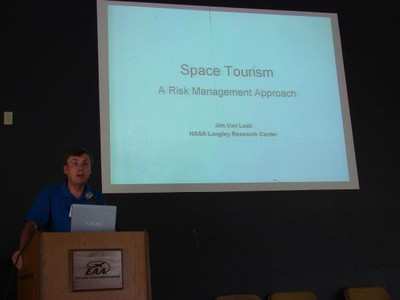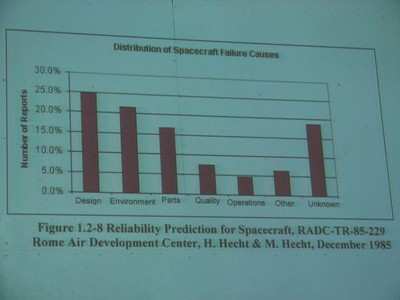NASA's Jim Van Laak Speaks At Oshkosh
by ANN Correspondent Chris Esposito
Jim Van Laak, of the NASA Langley Systems Management Office,
spoke at Oshkosh this week about the important of risk management
in the privatized spaceflight sector. Laak, who has been a pilot
for 37 years and owned 30 airplanes, knows risk well. In his
career, he has had eight engine failures and three fires in flight.
Laak's experience working with 21 Shuttle missions has given him a
unique perspective on the hazards inherent in manned
spaceflight.

Laak, who has also worked extensively with the American and
Russian space programs, reminds us that in spaceflight, there is
"lots of risk and people will ultimately get killed." With
suborbital flights possible for many in less than five years, and
privatized orbital flights possible in the next fifteen, a
successful risk management approach will be a necessity to ensure
continuing exploration in this field. "We're on the brink of a new
era where spaceflight for the masses is a possibility," says
Laak.

Governments spend billions of dollars on spaceflight and still
see casualties, despite huge efforts to avoid them. Spaceflight
cannot afford the bureaucratic nature of such huge organizations,
Laak reminds us. He mentioned the recent accident in Mojave
involving Scaled Composites, which Laak says is "another
illustration of the danger."
Laak cites the NASA saying "better, fast, and cheaper -- pick
two." Stressing environments and huge amounts of energy increase
the chances of failure; electronics and other ship materials will
have to deal with 500 degree temperature differentials in space.
Since the preferred method for personal space transportation seems
to be solid rocket motors because of their simplicity, design of
the spacecraft must incorporate features compatable with the
motors. "Solid rocket motors tend to make a great deal of
vibration." he says.

The solution, according to Laak, is to anticipate and mitigate
negative events. No operation can avoid risk in spaceflight, but
Laak urges the "intelligent acceptance of prudent risk."
Implementing comprehensive risk management will include simplifying
systems and designing products to be reliable in the space
environment, since there are "few opportunities to stop and sort
things out." says Laak. Aggressive, dynamic flight profiles should
be avoided, and prospective clients should be on the lookout for
unrealistic or unsubstantiated claims.
Invisible risks will also be inherent. Complex rocket systems
and software programs (which is sometimes not tested in the space
environment) are two items of immediate concern. Contingency plans
are another important factor, says Laak. "How will they respond if
they see a big yaw develop in ascent?" he asks.
To ensure success in privatized spaceflight, the companies
involved must embrace the lessons learned from NASA's space
missions. With the Shuttle, nonrealistic expectations combined with
engines operating at very high energy levels led to a program that
was extremely expensive in the long run. The issue with solid
rocket engines, says Laak, is "when you light the sucker, you hang
on 'till it's done." Hybrid engines, such as those being developed
for SpaceShipTwo, are easier to control because they can be
"throttled back," says Laak.

Successful designs are likely to be either winged or
parachute-equipped spacecraft. Vertical landing spacecraft are
inherently more complex, as systems must be designed to handle the
extra workload of a powered descent. Controllable hybrid rocket
engines that use an oxidizer are also more likely to be successful,
due to the increased chance of successfully aborting if a problem
arises.
Laak says that "attention to detail-figuring out and
understanding" will be a significant factor in problem solving,
especially in the spaceflight environment. With the recent accident
involving Scaled Composites, it is clear that inherent risk lies in
spaceflight, even during testing with an experienced crew. Laak
feels simplicity will be key in the future developments of personal
space travel.
 SpaceX to Launch Inversion RAY Reentry Vehicle in Fall
SpaceX to Launch Inversion RAY Reentry Vehicle in Fall Aero-News: Quote of the Day (04.23.24)
Aero-News: Quote of the Day (04.23.24) Aero-News: Quote of the Day (04.20.24)
Aero-News: Quote of the Day (04.20.24) ANN's Daily Aero-Linx (04.20.24)
ANN's Daily Aero-Linx (04.20.24) Aero-News: Quote of the Day (04.21.24)
Aero-News: Quote of the Day (04.21.24)






